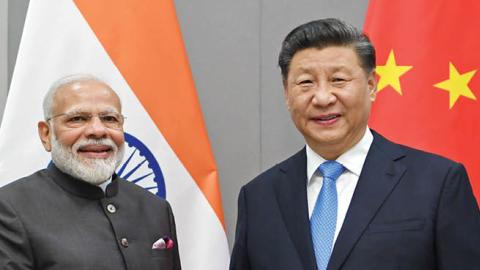India’s decision to move 50,000 additional troops to its border with China bolsters its ability to protect itself against Chinese aggression. It is a belated response to China’s actions last year, when the Chinese army surprised ill-prepared Indian soldiers and occupied several square miles of Indian territory in the Ladakh region to build roads and fortify military encampments.
The hope of some Indian policymakers to resolve the matter diplomatically has not so far been fulfilled. Several rounds of military and diplomatic negotiations since April 2020, when the Chinese incursions started, have yielded little result.
Any willingness on India’s part to deal forcefully with China would be welcomed in the U.S., where successive administrations have sought to integrate India into America’s Indo-Pacific strategy. Several years of an India-U.S. entente cordiale has been premised on India standing up to China.
After all, with a population of more than one billion, India is the only country with enough manpower to match that of China.
China sees India as a potential rival and covets parts of Indian territory. China occupied 15,000 miles of Indian territory in the Aksai Chin section of Ladakh after war in 1962. China’s desire for influence in South Asia and the Indian Ocean Region challenges India in its backyard, setting off competition for the same sphere of influence.
But China’s phenomenal economic growth, coupled with India’s inability to keep pace, has hampered India’s ability to respond to China strategically. Even now the moving of troops to Ladakh is a tactical maneuver not backed by a clear strategic plan.
On four occasions since 2012, China has indulged in salami-slicing along the largely un-demarcated India-China border. India’s response each time has been limited to diplomatic negotiations with limited military pushback.
There is a co-relation between relative economic strength and China’s willingness to flex its muscle. Between 1988, when India and China signed a series of agreements to restore relations, and 2012, the border between India and China remained by and large quiet.
During that period, the size of the two countries’ economies was not huge. In 1990, India’s GDP stood at $320 billion and China’s GDP at $413 billion. By 2012, China’s GDP had grown to $8.5 trillion, seven times larger than India’s $1.2 trillion economy.
The change in China’s policy after 2012, encouraging its troops to use force against India along the border, coincided with the rise in China’s military and economic power and its impact on the relative balance of power with India.
Like many in the West, India during the 1990s had bought into the view that deeper economic and diplomatic engagement with communist China would help maintain peace between the two Asian giants. But the India-China border dispute could not remain on the back burner as China became more aggressive in the wake of growing economic and military power.
India can no longer rely solely on diplomacy to deal with China. It will soon have to build and deploy hard power to deter the Chinese. The recent deployment along the Ladakh border could mark the beginning of that process.
With the latest addition, 200,000 of India’s more than a million strong army now face China along the 2,167-mile border. By way of comparison, 600,000 Indian troops are positioned along the 2,065-mile, fully fenced and fully demarcated border with Pakistan. It is inconceivable that any attempt by Pakistan to take territory would go unretaliated by India.
While India’s attempts over the last year have been to convince China, primarily through diplomatic engagements, to return the border to status quo ante, most military and strategic experts argue that China has no interest in resolving the border dispute with India.
India has for far too long acquiesced to Chinese aggression without sufficient retaliatory military action. India may not seek to provoke China into an all-out war, but it needs to find a sweet spot between ignoring and provoking.
The United States and its allies, too, would like India to act like a major power in not taking Chinese provocations lightly.
Western democracies and Japan have viewed India as an ideal partner and future ally in Asia and the Indo-Pacific. India has consistently been a democracy, shares pluralist values with the United States, and its embrace of free market reforms since 1992 have created an opening for expanded economic ties.
India also shares America’s concerns about China’s rising power. In developing a pivot to Asia or an Indo-Pacific policy, successive U.S. administrations have assumed that a shared concern about China makes India a natural American ally. India-U.S. relations were referred to as the “defining partnership of the 21st century” under President Obama. The Trump administration’s 2017 National Security Strategy spoke of India as a “leading global power” and a strong “strategic and defense partner.”
The Biden administration’s March 2021 “Interim National Security guidance” has described the “deepening partnership” with India as being critical to America’s “vital national interests.” But the Indo-Pacific policies of both the Trump and Biden administrations have focused on maritime security, ignoring India’s challenge from China on the continental landmass.
China views India as an inward-looking democracy that has yet to focus on economic growth or military prowess. Only an expansion in India’s economy and military capability would convince China’s leaders to view it differently.
Moreover, the two decades of celebrating convergence of democratic values and voicing of strategic concerns by Washington and Delhi now needs to be followed up with specific steps to counter Chinese hard power with Indian muscle.
Read in The Hill
















